A Garden of Survivors
where serendipity and inspired design go hand in hand
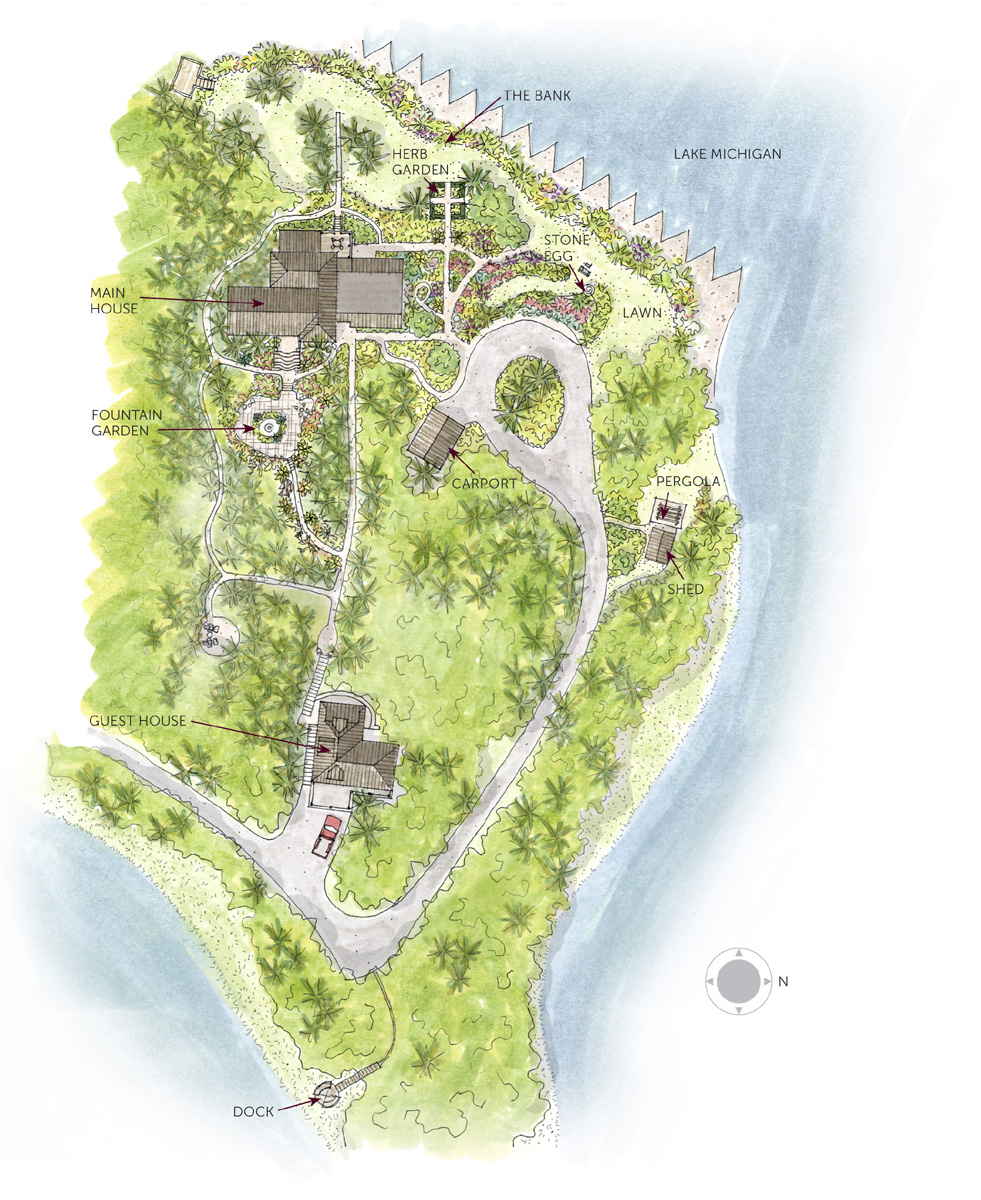
Design credits:
home of Joel Guillory and Janet V. Burch
designed by Maria Smithburg, Artemisia Landscape Design
The multi-tiered Italianate fountain was almost a deal breaker, seemingly incongruous with the casual vacation home Janet and Joel were seeking. Yet the sandy, unpaved road that led to the home in the Grand Mere neighborhood of Michigan piqued their curiosity, so putting their initial misgivings aside Janet and Joel arranged to view the property. Parking adjacent to an unpretentious, two-story building they began to relax, satisfied that this was going to be just right for their needs after all. Smiling, the realtor explained that this was just the guest house; the primary home was farther up the hill.
The main residence, built around 1916, was a quirky blend of architectural styles with an intriguing history. The basement still houses a small room that appears to have been used as a safe room or prison cell. The 18-inch-thick concrete walls, ceiling, and floor that encase the space—together with three sets of steel doors complete with viewing grille—certainly suggest the latter, and it is believed that the home was originally built for one of Al Capone’s infamous gang members. For Janet and Joel, the primary consideration was the location, however. They both worked long hours in Chicago, Janet as an ophthalmologist and Joel as a cardiac surgeon, and they relished being able to escape the city on weekends. “It felt as though we were thousands of miles away,” Janet recalls of that first visit. The setting on a sandy dune above Lake Michigan, together with a private dock on an inland lake, afforded ample opportunities for bird watching and hiking, two of their favorite pastimes.
It took a few years to update the home, a priority being to open up lake views to the north, but when it was time to tackle the overgrown landscape Janet was at a loss. The existing garden was reminiscent of a neglected public park: an asphalt parking lot installed by the previous owners dominated the sunniest area, the shady entry garden linking the guest house and main home was mostly weeds (accented by the ornate fountain), and the large, weedy lawn was bordered by an unkempt bank of yet more weeds. Wild grapevines grew up many of the trees, and poison ivy was rampant, a real problem for Joel and Janet, who are both highly allergic to this pernicious weed. They had to don special protective outfits that covered them from head to toe before venturing outside to tackle the noxious thug. “It was insane!” Janet laughs.
Although Janet had enjoyed growing vegetables as a child, encouraged and mentored by both her parents, gardening in New Orleans was a far cry from Michigan. Used to hot, sultry summers that supported the year-round exuberant growth of colorful tropical plants, she was now faced with long, snowy winters and sustained winds of fifty miles per hour that sprayed water from the lake across the garden and onto the windows, conditions that killed all but the hardiest of plants. “The winter storms make it hard to be outside, let alone do any gardening,” she says. It is not unusual for shallow-rooted conifers to be torn from the ground and branches to be scattered across the garden. Late freezes are also a challenge, especially to her favorite hydrangeas, which can suffer repeated dieback in the unpredictable spring weather.
This firsthand experience has taught Janet that regardless of what books and local experts might recommend, all her planting and transplanting must be done in spring, as soon as the ground can be worked. Nothing planted in fall—whether a perennial, shrub, or tree—survives the winter in this harsh environment.
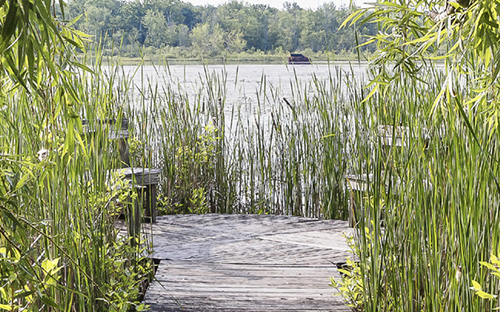
A trail leads to the private dock, a favorite spot to sit and watch the many marsh birds.
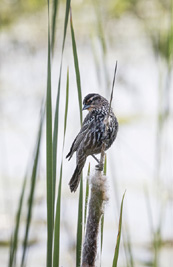
Songbirds can often be seen perching on the cattails or wetland shrubs that surround the dock.
Taming the Wilderness
Janet realized she needed professional help and a focused vision, so turned to Maria Smithburg of Artemisia Landscape Design. Maria is an intuitive artist, seeing the terrain as her canvas and the plants as her palette. After walking the property and assessing views from each window in the house, Maria took her design inspiration from the lake, which dominated every vista. Using graceful curves and sweeping, parallel arcs, she mimicked the ripples of water when designing steps, paths, and planting beds, these ripples becoming bolder and wider as they moved farther away from the house. The garden is designed to be appreciated from above; every window now offers a framed view of the garden and lake to the northwest or a treetop view to the east.
The asphalt parking area was removed to make way for a series of sunny garden borders and lawn intersected with gently curving paths of Wisconsin Lannon stone; the driveway was reworked to culminate in a wide turning circle and covered carport. Janet also requested a small area to grow herbs; the designer, therefore, included a boxwood-trimmed garden laid out in classic four-quadrant style, its gravel and cobble pathways edged with brick. Pink and white rugosa roses (Rosa rugosa) line the nearby bank and perfume the air, and the self-seeding of rose campion (Lychnis coronaria) and stonecrops (Sedum) into the gravel pathway is encouraged.
A wooden shed and pergola were added at a high point on the bluff; the shaded canopy is now a favorite spot to enjoy lunch or an evening glass of wine while listening to the gentle lapping of the waves below. Initially, Janet planted a native grapevine on the pergola but sadly it succumbed to phylloxera. It has been a matter of trial and error to find a replacement vine that will thrive in that location, but a climbing hydrangea (Hydrangea anomala subsp. petiolaris) is now doing well, while wisteria, clematis, and a kiwi vine (Actinidia kolomikta) are still struggling to become established.
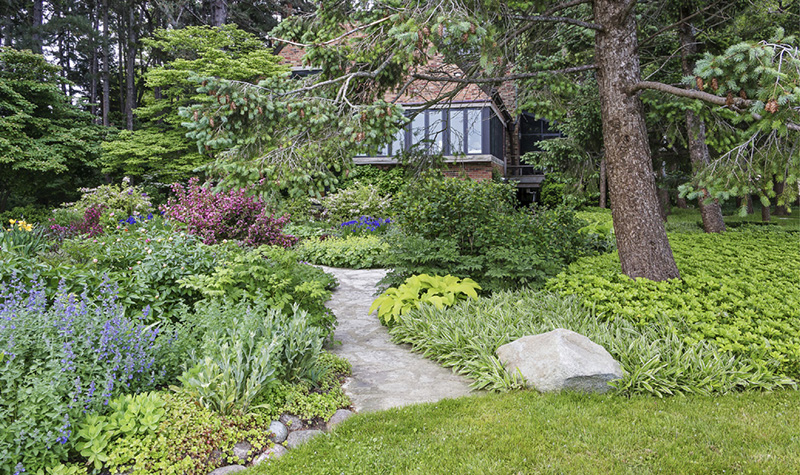
Sweeping curves of lawn, stone, and plants simulate rippling water.
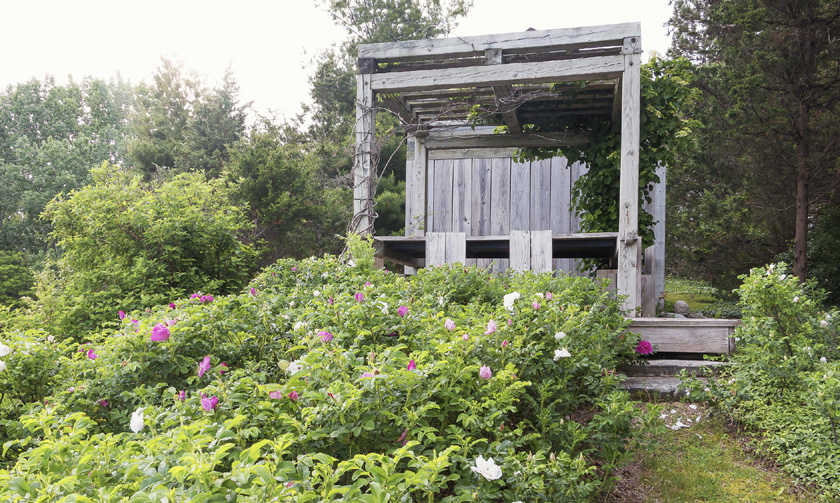
Climbing hydrangea (Hydrangea anomala subsp. petiolaris), a signature vine used throughout the property, scrambles up the sturdy pergola, offering shade. Deer nibble the rugosa roses (Rosa rugosa) but leave enough to be enjoyed.
Janet next turned her attention to the fountain garden, which she envisioned as an area to showcase shade-tolerant perennials that would also suppress the weeds. Maria suggested first balancing the scale of the towering conifers and oaks by creating an intermediate understory of doublefile viburnum (Viburnum plicatum f. tomentosum) pruned to resemble small trees, revealing their sculptural form. Maria also addressed a significant design challenge: the formal fountain was not on axis with the main path to the house. To balance this awkward asymmetry, the designer added a Wisconsin Lannon stone and brick patio to span both sides of the path, encompassing the fountain and creating two intimate seating areas, accessed from the home by a series of semicircular steps.

Hostas are sprayed regularly with a deer repellent, a measure Janet feels is necessary since their bold foliage is a key component of the fountain garden.
Working with Wildlife
Deer were the least of Janet’s concerns in the early days. She naively considered them “quite cute,” blissfully unaware of the havoc they could wreak, so her initial plant selection did not focus on deer resistance. It didn’t take long, however, before she realized these deer were not merely passing; rather they saw her garden as offering tasty supplements to their more traditional diet. That wasn’t good news for the countless hydrangeas and hostas Janet had already planted. Her goal, however, was not to create a garden that deer wouldn’t destroy; it was to create the garden she really wanted—and then deal with the deer. With this patient approach, Janet fashioned cylinders from chicken wire to protect the young oakleaf hydrangeas (Hydrangea quercifolia) that she was determined to grow, noting that when the shrubs got larger the deer didn’t seem to be as interested (although she admits that could easily change in the future). And while the deer ignored the sumptuous hostas for many years, as soon as Janet noticed the emerging perennials were being browsed, she asked her garden maintenance company to begin a spraying regime of deer repellent (used at a slightly higher concentration than usually recommended), which has proven effective.
Rabbits and groundhogs were also increasingly problematic. Emerging daylilies (Hemerocallis), lilies (Lilium), and coneflowers (Echinacea) became choice treats for the groundhogs, the tender young shoots proving particularly irresistible. Janet set to work with smaller chicken-wire cylinders to protect these, which worked well until the lilies grew taller than the cages, at which point the deer ate the exposed buds. The revised plant palette was the result of natural selection, as browsing, soil, and climate all took their toll. “It’s a garden of survivors,” says Janet philosophically.
From Parking Lot to Painting
Looking at the garden today it is hard to imagine this painterly scene was once a weed-infested parking lot. Climbing hydrangeas thrive on the home’s brick façade, while the vibrant foliage of barberries (Berberis) and weigelas ensure color even when flowers are not in bloom. Vertical spikes of Siberian iris (Iris sibirica), bearded iris, and ornamental onions (Allium) punctuate the mounding peonies, catmints (Nepeta), and geraniums, while lady’s mantle (Alchemilla mollis) adds a frothy chartreuse ruffle along the paths. Focal points are established using bold foliage such as edible rhubarb (Rheum rhabarbarum), large urns, and a distinctive stone sculpture in the shape of an egg, which appealed to Janet for its simplicity of form.
The dramatic, dry-stacked stone egg was created by local artist Todd Brooks, in the style of one designed by British sculptor Andy Goldsworthy. The sculpture took three weeks to build and necessitated a 4-foot-deep foundation of poured concrete, a pier, and rebar, which runs through both the pier and stonework. The egg itself is constructed from nine tons of Fond du Lac flagstone. Todd first sketched out every layer of stone, meticulously calculating the size of each piece, which was then cut to shape and fine-tuned with a hammer and chisel.

The sculptural dry-stacked stone egg sits at the end of a grass peninsula, framed by flowers and foliage. A nearby bench offers a peaceful setting to enjoy the view across Lake Michigan.
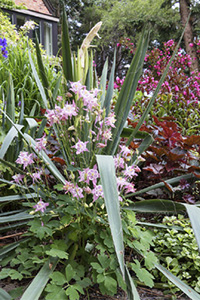
Pale pink blooms of a volunteer columbine wind through Adam’s needle (Yucca filamentosa), a cold-hardy species that has naturalized in Michigan. The dark foliage of coral bells (Heuchera villosa ‘Palace Purple’) and weigela (Weigela florida ‘Wine and Roses’) add depth to the scene.

Cobalt-blue Siberian iris (Iris ‘Caesar’s Brother’) is a vivid counterpoint to the softer-hued lady’s mantle (Alchemilla mollis) and variegated weigela (Weigela florida ‘Variegata’).

Edible chives (Allium schoenoprasum) and yellow loosestrife (Lysimachia punctata) mingle with oxeye daisies (Leucanthemum vulgare) on the sandy bank.
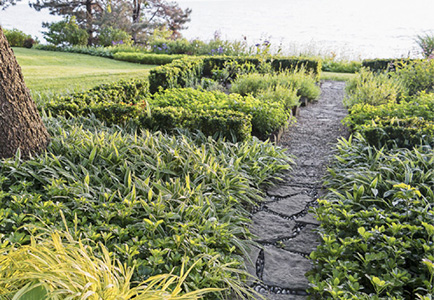
The hedged herb garden adjoins this textural feast, the flavors of basil and oregano just moments from the kitchen.
Janet insists that the plant selection has been driven more by what survived rather than specifically aiming for deer resistance at the outset. While both she and Maria expected silver-leaved plants to thrive in the fast-draining soil and sunny site, the humidity quickly caused their demise, while the rabbits’ voracious appetite for coneflowers thwarted her desire for a vast swath of these classic perennials. Yet even with these restrictions, together they have created many striking vignettes and colorful plant combinations that withstand both the wildlife and weather. Irises have proven to be reliably deer-resistant in the garden, so Janet has enjoyed incorporating many different species and colors.
With so many perennials in the garden, regular division is part of the ongoing maintenance, but Janet puts these divisions to good use by adding them to the informal bank of flowers, creating what has gradually evolved into a botanical Impressionist painting. Entirely spontaneous and serendipitous, this charming scene dances in the slightest breeze, attracting butterflies and bees.
Increasing shade under the pine trees means a change of pace, a reliance on textural foliage and a soothing monochromatic color scheme using shades of green ranging from bright chartreuse to deepest emerald. It is in this area that the designer’s artistic flair really shines as she has used bands of different groundcovers, discreetly separated by landscape edging, to create a curvilinear design. Rosettes of pachysandra (Pachysandra terminalis) are juxtaposed with wide green-and-white blades of creeping broadleaf sedge (Carex siderosticha ‘Variegata’) transitioning with ease into the clipped boxwood hedge surrounding the herb garden. As more light penetrates the canopy, the larger leaves of hosta and bugbane (Actaea simplex) are introduced, with golden Japanese forest grass (Hakonechloa macra ‘Aureola’) cascading at intervals onto the flagstone path.
Transforming the Fountain Garden
Having learned so much from Maria, Janet felt ready to design the plantings of the fountain garden on her own, and it is this area that she feels best reflects her style. Following Maria’s cue to first create an understory of shrubs that resemble small trees, Janet added additional doublefile viburnums, as well as introducing oakleaf, smooth, and mophead hydrangeas.
Using the fountain as a focal point and the existing mature rhododendrons as inspiration, Janet began to weave shade-loving perennials into a richly textured carpet, experimenting to see what would survive, and while some of the combinations were planned, she confesses that many are purely by chance. Around the sunken patio, feathery ferns and astilbes jostle with multi-hued hostas and leopard plant (Ligularia dentata ‘Othello’); the placement of the leopard plant is ingenious, as its burgundy stems and leaf undersides are most easily appreciated when viewed from below. The strategic use of deer repellent on vulnerable plants enables her to manage what is otherwise a low-maintenance design, rich in textural details and elegant in its monochromatic simplicity. “I don’t even cut it back in fall,” says Janet. “It dies back over the winter and can all be raked up in early spring.”
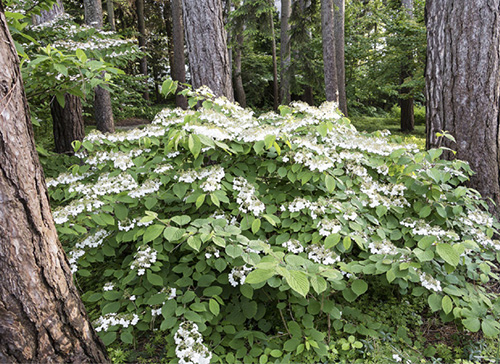
In the fountain garden, the horizontal tiers of a doublefile viburnum (Viburnum plicatum f. tomentosum ‘Mariesii’) are allowed to mound to the ground.

A metallic ribbon of Japanese painted fern (Athyrium niponicum var. pictum ‘Pewter Lace’) weaves through a carpet of leopard plant (Ligularia dentata ‘Othello’), assorted hostas, and delicate star astilbe (Astilbe simplicifolia ‘Hennie Graafland’).

Variegated Solomon’s seal (Polygonatum odoratum var. pluriflorum ‘Variegatum’), mayapple (Podophyllum peltatum), and sensitive fern (Onoclea sensibilis) give way to a carpet of sweet woodruff (Galium odoratum) at the garden’s perimeter.

Survivors: not only the fountain and rhododendrons but cottonwood (Populus) snags have been left in place, reminiscent of ancient columns around a sunken amphitheater.
Although Janet was unable to replicate the flamboyance of her New Orleans garden, she did discover several shade-loving perennials with large, tropical-looking leaves and has incorporated many of these into the fountain garden, including Rodgers’ flower (Rodgersia podophylla) and giant Japanese butterbur (Petasites japonicus var. giganteus); all have proven to be deer-resistant. To transition from this intricately woven tapestry to the far reaches of the garden, which are more naturalized, Janet gradually simplified the plant selection, using fewer and fewer plants, until only sweet woodruff (Galium odoratum) and lily-of-the-valley (Convallaria majalis) remain.
Janet laughs as she recognizes the irony, admitting that the fountain garden is now one of her favorite areas.
Top 10 Plants

Black bugbane (Actaea simplex Atropurpurea Group). A wonderful architectural perennial, 4–6 feet tall, 2–4 feet wide, with dark, divided foliage and numerous tall spires of fragrant white flowers in late summer. Prefers rich, moisture-retentive soil and protection from strong winds. Partial shade–full shade, zones 3–8. Deer resistance: B.
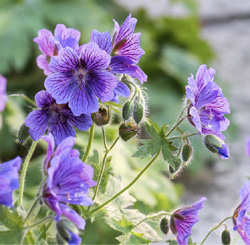
Johnson’s Blue geranium (Geranium ‘Johnson’s Blue’). Large periwinkle-blue flowers are held high above the finely cut foliage in late spring. In fall the foliage takes on brilliant orange and red tones, extending the season of interest even further. To 1–1.5 feet tall, 2–2.5 feet wide; shearing this herbaceous perennial after blooming will help maintain a more compact shape. Full sun–partial shade, zones 4–8. Deer resistance: C.
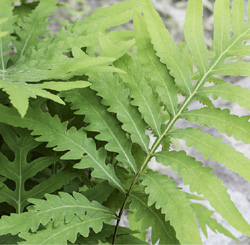
Sensitive fern (Onoclea sensibilis). This popular fern gets its name due to its sensitivity to cold temperatures, the soft green fronds turning yellow and dying down with the first frost. It spreads freely in moist soil and is an effective presence from spring until fall, at 3–4 feet tall and wide. Partial shade–full shade, zones 4–8. Deer resistance: A.
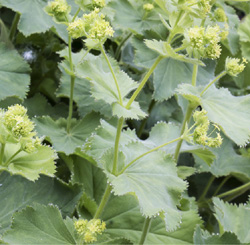
Lady’s mantle (Alchemilla mollis). Cultivated since the nineteenth century, this classic cottage garden perennial is an attractive edging for borders and paths. The hairy, scallop-edged, light green leaves retain beads of moisture that sparkle like diamonds after rain or the morning dew, and the sprays of lime blooms are popular in floral arrangements. Deadheading is recommended to avoid self-seeding, which can be excessive. Grows 1–1.5 feet tall, 1.5–2.5 feet wide. Full sun–partial shade, zones 3–8. Deer resistance: B.
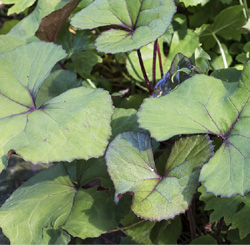
Othello leopard plant (Ligularia dentata ‘Othello’). Large, leathery, round leaves are olive-green on the upper surface and deep burgundy on the reverse, a perfect foil for the bright orange daisy-like flowers that appear above them in summer. Grows 2–3 feet tall, 1.5–2.5 feet wide. Protect from afternoon sun and provide plenty of moisture for this perennial to thrive. Bait for slugs as necessary. Partial shade–full shade, zones 3–8. Deer resistance: A.
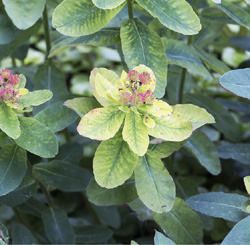
Cushion spurge (Euphorbia polychroma). The pale green foliage forms a dome-shaped cushion, 1–1.5 feet tall and wide, topped in spring with electric-yellow bracts. Thriving in dry, well-drained soils and full sun, it is a long-lived perennial, although self-seeding may be a problem if not deadheaded. Zones 4–8. Warning: the sap may cause irritation; protect skin and eyes. Deer resistance: A.
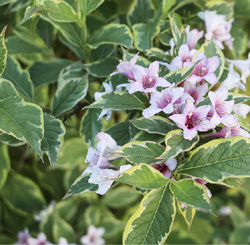
Variegated weigela (Weigela florida ‘Variegata’). Even when not in bloom, creamy-margined leaves of this deciduous shrub shine as if backlit. Tubular pink blooms appear in early summer, attracting hummingbirds. An easy-care specimen shrub for the landscape, 6–8 feet tall and wide. Full sun, zones 4–8. Deer resistance: B.
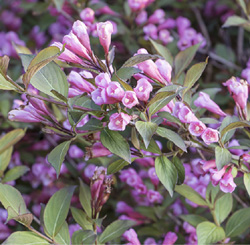
Spilled Wine weigela (Weigela florida ‘Spilled Wine’). This compact variety, 2–3 feet tall and wide, maintains a tidy mounding habit even without pruning. The dark foliage retains its color well throughout the season and offers an exciting contrast to the deep pink tubular flowers that appear in late spring. Full sun, zones 4–8. Deer resistance: B.
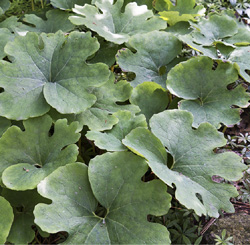
Plume poppy (Macleaya cordata). A vigorous, spreading and self-seeding perennial that some may consider aggressive to the point of being invasive, so seek advice from your local extension office before planting. Grows 5–8 feet tall, 2–4 feet wide. The lobed leaves are highly attractive, especially when backlit by the sun; the airy flower panicles are reminiscent of smoke plumes, hence the common name. Full sun–partial shade, zones 3–8. Warning: the sap is toxic; wear protective gloves when handling. Deer resistance: B.
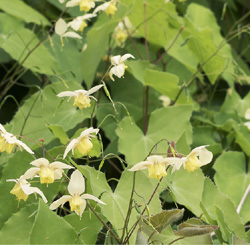
Yellow barrenwort (Epimedium ×versicolor ‘Sulphureum’). A vigorous groundcover, 1 foot tall, 1–1.5 feet wide, for dry shade with year-round interest. The heart-shaped, evergreen foliage may be tinged with red or bronze in dappled shade. In spring this hardy perennial produces a constellation of diminutive yellow and white flowers. Partial shade–full shade, zones 5–9. Deer resistance: A.